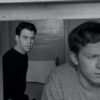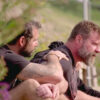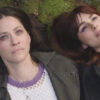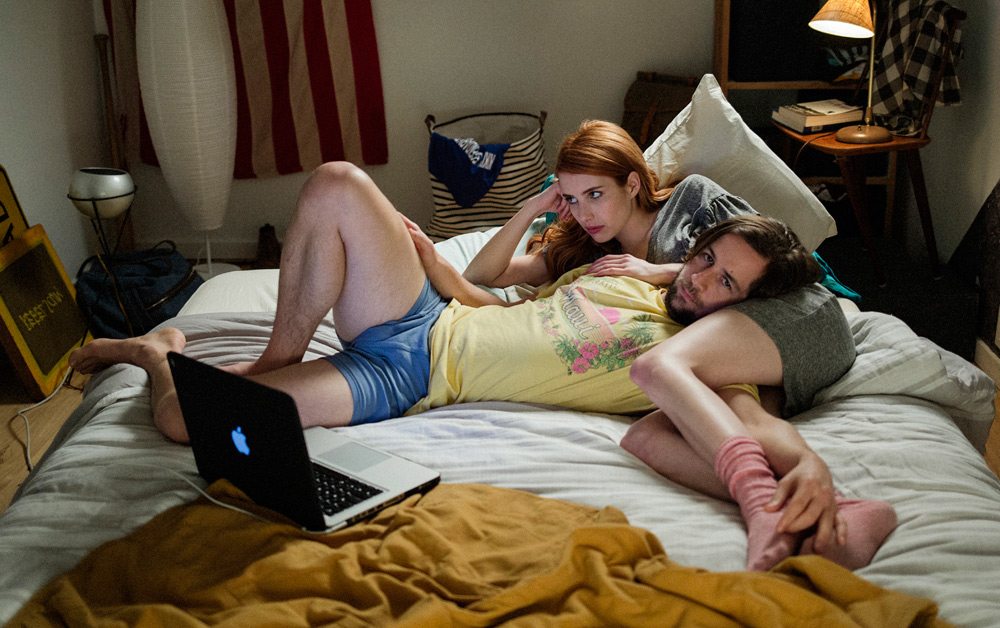With “In a Relationship,” Sam Boyd had always set out to make to make a breezy, summertime romantic comedy in Los Angeles, though he didn’t anticipate just how breezy it would get.
“We were shooting in February during El Niño,” says Boyd, reflecting on some of the minor hiccups for the otherwise smooth production. “For instance, there’s a scene where [all the characters are] in a pool at night and of course, the pool heater broke an hour before we shot, so that was a nightmare, but it was conquerable and we got really lucky that it was only minor things like that. [Still] if someone were to go back through the movie and pay attention to the elements of winter clothing in this summer movie, there’s definitely more beanies and thick socks than I’d like.”
It’s all too perfect that things weren’t as sunny as they appear in Southern California for “In a Relationship” a feature-length adaptation of Boyd’s 2015 short film of the same name in which the writer/director brings out both the comedy and the barbarism inherent in the jagged edges of two couples where the people involved don’t quite find themselves on the same page. In Los Angeles, he rides shotgun with Hallie (Emma Roberts) and Owen (Michael Angarano), who have been together since college yet no longer consider their habit of fighting at parties as a sign of their desire to stay committed to one another, and Owen’s friend Matt (Patrick Gibson), who has recently become besotted with Hallie’s friend Willow (Dree Hemingway), only to discover she’s interested in something far more casual than he is. While obviously those involved are on different timelines, both in relation to one another and within their own partnerships, the sparks that fly when they’re not in conflict make a compelling case for why they should stick together even if they aren’t an ideal fit.
In the romcom canon, “In a Relationship” also proves an unusual fit, but is all the more refreshing for it, not only in offering a vision of romance that involves compromise, but also showing how each couple can revel in the quirks of their own specific relationship that no one else may understand but them. For a pair of true crime binge-watchers like Matt and Willow, nothing may be more romantic than a day spent touring Brentwood retracing the steps of the O.J. Simpson murders and for Hallie and Owen, foreplay can include talk of “The Theory of Everything,” and while you can constantly feel the ground shifting beneath their feet, as Boyd explains, it was a challenge to make a film about relationships that reach a standstill, where the fear of moving on or ahead is paralyzing, yet he nonetheless created something gently moving in the process. Following the film’s premiere earlier this year at the Tribeca Film Festival, “In a Relationship” arrives this week in theaters and Boyd spoke about honoring the complexities of a relationship with an equally complex structure to the screenplay.
After seeing the feature, I went back and saw the short, which has a mockumentary frame to it. I think you made the right choice to discard it for the feature, but did you ever consider it?
Yeah, there were versions early on where I thought about it, but it really helped for the short because it was on the longer side for a short at 20 minutes long, so I was already trying to cover a lot of ground, and the mockumentary aspect, which was really me looking at “Husbands and Wives” and ripping it off wholesale, made a lot more sense because it enabled us to establish things quickly. Then in the feature, we felt like we didn’t need it as much. Every time I tried writing with the mockumentary aspect, it just felt a little superfluous. I also had a new aim, which was to make a feature that felt as natural as possible, so instead of this device that really made it feel like a movie, it was fun to be able to strip that out [where] this movie would feel like we’re in the room with these characters and there’s no crazy dolly shots or tricky camerawork. It’s just about how we truthfully and beautifully present what this would really be like and letting that be enough.
I understand you like adapting to the actors that you have – what was it like finding a cast and then allowing them to take it in different directions than you may have had on the page?
That’s always the goal. A filmmaker I really love is Richard LInklater and I really have learned a lot about his process and the way he gets the performances he gets. So a lot of it for me is this attitude of starting with the script as this blueprint, and I work as hard as I can on the script and flesh out the characters as much as I can, but also know there’s only so far I can take it until I bring other people into the fold who can help me deepen and strengthen and complicate everything. [This film] really lives or dies on the performances, so I felt really lucky to have this ensemble and to have not just each individual actor to be so right for their particular role, but to have each romantic relationship to feel credible. The four of them as a whole really feel right and it was amazing to be able to bring them together and then just kind of see what happens.
A lot of the times in the movie, maybe it’ll be lines in a given scene — [where] lines one through five are from the script and then lines six, seven, and nine are just because I don’t say “cut,” I just wanted to see what would happen. And there’s definitely stuff from the script that people like in the movie, but certain lines, like the thing about “Can we take pictures of sushi to put on Yelp” or some of the cruder stuff about the Stephen Hawking movie [“The Theory of Everything”] at the very beginning, just happened [spontaneously]. I tried to create an environment for the actors where [we weren’t] cutting it up and doing 30 or 60 seconds of a scene at the time, but letting them run the whole scene through, trying to play it like it’s something that was really happening to them and letting them live in that moment and hoping that we got some magic. That’s what you’re chasing — the accidents and the magic and the things that you could never write or anticipate. That’s what makes the movie feel really alive, especially one like this.
Both in geography and culture, you really get the feel of Los Angeles right. What was it like figuring that out?
I was born in the Bay Area, and I went to NYU for film school, but I grew up in Santa Monica and I’ve been back in L.A. since college, so I really love Los Angeles and I had seen so many movies that felt like the movie version of L.A., even smaller movies that were trying to be more realistic. It still felt like we were seeing the Venice sign or the same stuff on the east side, so I took on the goal of just wanting to depict and portray landmarks that were personal to me. The same way that I [wanted to capture] the minutiae of being in a relationship in general, it also became about how do we show something like the OJ tour [of Brentwood] or put them in a place like the Echo or the Good Luck Bar, things that you may not see as much [in other movies], but whether or not an audience member gets the reference point, it’ll come through that these are the streets that I grew up on and the places that I went, just wanting to give the movie a personal sense of place.
And it’s pretty great how you work in the O.J. Murder Tour, a real thing in L.A., that becomes a grand romantic gesture in the film. How did that come into play?
From the beginning, part of what was fun about writing the movie was finding ways to do exactly that – to say, okay, this is a romantic comedy and we want to have the things that a romantic comedy are supposed to have, so you want the grand romantic gesture or the moment of the guy realizing he misses the girl and running to her, but how do we do those in ways that are funny because we’ve never seen it that way before? With the OJ tour especially, I liked the idea of [bringing together] true crime aficionados, which I am one, and [having] Matt thinking taking her on this OJ tour would be a really great idea just felt really true to L.A. and to the macabre fascination [people have] with stuff like that and think is fun. I had never really seen that in a movie date context, so it felt like a sweet thing I hadn’t really seen before and maybe that’s closer to the way it could really happen.
This may go back to the writing, but when you have these parallel relationships as part of the narrative, do they inform each other or do their take on their own lives and the intersections happen organically?
Definitely [the former], especially because I set out to make a film that was intentionally plotless, but without sacrificing entertainment value – that was really the tightrope that we were walking. How do we make this satisfying in the way that a romantic comedy is satisfying, but without bogging it down a lot of the fake problems and plot contrivances that filmmakers normally go to to make the film feel bigger or “more entertaining”? [So it became a question of] if I’m not going to use plot to keep people interested, how else are we going to make sure the audience is never bored? And that really became about putting a lot of work and thought into the structure and beyond being able to subvert and twist romcom conventions in that way, it also became about looking at each couple as a point/counterpoint to the other as a way of giving this film momentum and an engine. Literally in writing it, I would create documents and diagrams where I was mirroring each couple so each time something was good for one couple, it was bad for another and they were constantly ping-ponging back and forth. In addition to keeping the movie interesting, it just felt true to what it’s like [to be in a relationship], which is even when it’s bad, there’s nice moments and even when it’s nice, there’s bad moments. That constant flip-flopping just felt more like the way it really is as opposed to something being all one way or the other.
I don’t want to spoil the film, but it ends on a striking closing shot, which is similar to how you end the short, where you picture the couples at a remove. What made that image so sticky for you? [Minor spoilers ahead]
There’s two aspects of it. In the short, I definitely did the same thing which was ending the movie with these two couples back where it began, and in general, that concept just felt really right for me because I didn’t want the movie to be prescriptive. It wasn’t about answers or really even questions. It was more about chasing feelings and a kind of melancholy, an unknowable wistfulness that comes with seeing a relationship run its course and then watching the hope with which it started. That just felt like a really sweet idea to me, especially in a movie that’s otherwise extremely linear, to have this one time jump. That was always one of the most exciting aspects of the movie to me as I was writing both the short and the feature.
In the short, the version of that shot is literally them sitting in the backyard — it’s not super-heightened — and it’s only supposed to be a couple months earlier, but it still has that time jump, and for the feature, I wanted to ratchet it up a notch, [where there’d be] this time jump back to when the four characters had been living in New York five years ago when everything in the movie started with each of these couples. As the cinematographer Martim Vian and I were shotlisting [before production], it just felt exciting to be able to take this movie [where] everything else in this movie stylistically had been as naturalistic as possible and linear [chronologically], [to the point] it felt like to us we had earned the opportunity to end this voyeuristic, documentary feeling kind of movie with not just the most cinematic thing in the movie, but maybe the only epically cinematic [moment] with this composed shot that would be impossible for a documentary. With the CGI snow that’s in there, all the elements hopefully come together to create the most emotional and poignant moment in the movie.
“In a Relationship” opens on November 9th in Los Angeles at the Los Feliz 3 and in New York at Cinema Village. It is also available on iTunes.





Comments 1